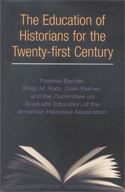By Thomas Bender, Philip M. Katz, Colin Palmer, and the Committee on Graduate Education of the American Historical Association
 Contents
Contents
Part 1: Report and Recommendations
Part 2: Foundations
4. The National Shape of Doctoral Education: A Survey of Graduate Programs
Appendix A: Consultations with the Discipline
Appendix B: List of Respondents to the Graduate Program Survey
Selected Bibliography on Graduate Training and Historians
Committee Members
Committee on Graduate Education
Colin Palmer, Princeton University, Chair
Thomas Bender, New York University, Secretary
Constance Berman, University of Iowa
Allison Blakely, Howard University/Boston University
Ramón A. Gutiérrez, University of California at San Diego
Fiona D. Halloran, University of California at Los Angeles, student representative
Nadine Hata, El Camino Community College
Lynn Hunt, University of California at Los Angeles
Stanley N. Katz, Princeton University
Theresa Mah, Bowling Green State University
Kristin Stapleton, University of Kentucky
Arnita Jones, American Historical Association, ex officio
Philip M. Katz, Research Director
Miriam E. Hauss, American Historical Association, staff
Board of Advisors
James Banner, independent historian
Jacques Barzun, Columbia University, emeritus
Jerry Bentley, University of Hawaii at Manoa
David Berry, Community College Humanities Association
Richard Bulliet, Columbia University
Dipesh Chakrabarty, University of Chicago
Frederick Cooper, New York University
James Banner, independent historian
Katherine Fleming, Boston College
Robin Fleming, Boston College
Lee Formwalt, Organization of American Historians
Michael Galgano, James Madison University
Sam Gellens, Horace Mann School (New York City)
Patricia Graham, Harvard Graduate School of Education
Sean Greene, University of Pennsylvania, student representative
Jim Grossman, Newberry Library
Carl Guarneri, St. Mary’s College of California
Lillian Guerra, Bates College, student representative
Melanie Gustafson, University of Vermont
Evelyn Hu-DeHart, Brown University
Henry Kiernan, West Morris (N.J.) Regional High School
James Kloppenberg, Harvard University
Earl Lewis, University of Michigan
Vernon Litdke, John Hopkins University, emeritus
Patrick Manning, Northeastern University
Saje Mathieu, Princeton University
John Morrow, University of Georgia
Edwin Perkins, University of Southern California, emeritus
Ileana Rodríguez-Silva, University of Wisconsin at Madison, student representative
Roy Rosenzweig, George Mason University
Linda Shopes, Pennsylvania Historical and Museum Commission
Victoria Straughn, La Follette High School (Madison, Wisc.)
David Trask, Guilford Technical Community College
Mary Ann Villarreal, University of Utah, student representative
Lee Palmer Wandel, University of Wisconsin at Madison
Allan Winkler, Miami University
Barbara Winslow, Brooklyn College School of Education
Caroline Winterer, San José State University
Charles Zappia, San Diego Mesa College
Acknowledgements
Hundreds of people helped make this report a reality. First we want to thank the Directors of Graduate Studies (or other faculty representatives) at 105 doctoral programs who took the time to complete a forty-one-page questionnaire and thus provided a foundation of data upon which to build the entire report. Department chairs also helped substantially by responding to an informal e-mail survey that helped shape the detailed questionnaire. Chairs, graduate directors, and other staff members at the nine history departments where we conducted site visits also provided crucial assistance. They provided us with a forum for testing our ideas and confirming the information gathered from the larger population of graduate departments—and they were generous hosts. Graduate deans and other administrators at these schools also provided an invaluable perspective on the issues we were exploring.
Graduate students played a significant role in developing this report. The American Historical Association’s Task Force on Graduate Education (later the Committee on Graduate Students) provided many helpful suggestions for the development of the survey and on successive drafts of the report. Members of the Committee on Graduate Students, along with graduate student members of our Advisory Committee and other consultants, participated in site visits and helped conduct independent meetings with students at the campuses we visited. Graduate student leaders at the nine campuses shared their views with the visiting committee. Dozens of graduate student members of the AHA responded to a call for comments on the preliminary results of this study; another group of students graciously agreed to review a draft of the report.
The Advisory Committee shared with us their substantial experience and expertise every step of the way as we gleaned and sifted the information contained in these pages. We especially appreciate their timely critiques of various drafts of the report.
We are also grateful to the many historians who took the time to participate in site visits or to meet with representatives of the Committee on Graduate Education at a dozen open forums. (Three of these forums were held during annual meetings of the AHA; the rest took place at meetings of other historical associations, and we would like to thank their leaders for providing us with access to the programs.) Other historians shared their concerns with the Committee via e-mail, surface mail, and the telephone; we thank them, too. Several scholars of higher education and higher education administrators read and generously commented on the report. The Committee on Graduate Education also profited from its several exchanges with a complementary study of history education being undertaken by the National Council on Education and the Disciplines.
Two AHA staff members were indispensable to our efforts, going above and beyond the call of duty on numberless occasions. Miriam E. Hauss provided logistical and administrative support for the Committee’s many activities. Robert B. Townsend helped us frame the study with earlier data collected by the AHA and other researchers; formatted and analyzed the data from the survey of doctoral programs; and was an unparalleled source of statistical and other expertise.
Finally, we owe a large debt of gratitude to the Carnegie Corporation of New York for its financial support.


